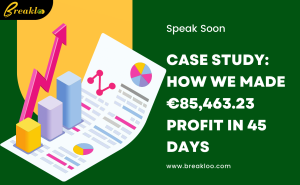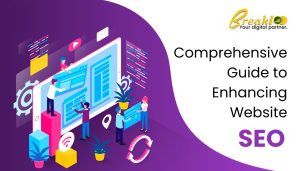12 SEO Factors Hindering Your Success and How Breakloo Digitals Can Help You Overcome Them
According to Ahrefs, a staggering 90.63% of content receives no organic traffic from Google, and a mere 0.21% garners 1,000 monthly visits. 12 SEO Factors Hindering Your Success why is this happening? What factors could be impeding your search engine optimization (SEO) efforts and preventing higher rankings?
Here are 12 common factors that might be hindering your SEO progress:
-
Keywords Aren’t as Competitive as You Think!
The higher the competition for a particular keyword or phrase, the longer it takes to achieve a higher ranking. For those new to SEO, focusing on long-tail keywords with lower competition is crucial. These keywords, while having lower search volumes, are more specific and targeted, making it easier for your website to rank higher. Additionally, targeting less competitive keywords helps establish your website’s authority in its niche, paving the way for future rankings for more competitive terms.
Solution:
– Conduct thorough keyword research using tools like Google Keyword Planner, SEMrush, or Ahrefs.
– Analyze your competition and identify keywords they are not targeting.
– Use long-tail keywords that incorporate specific phrases or questions related to your niche.
– Prioritize targeting keywords with a lower difficulty score.
– Monitor competitor keyword rankings and target similar or related keywords for your website.
-
Poor Site Architecture
Poor site architecture refers to the structure and organization of your website, significantly impacting search engine crawlability and indexing. A logical and organized site structure makes it easier for search engines to crawl and index your site, helps distribute link authority, and enhances user experience.
Solution:
– Use a clear and logical hierarchy for your website’s pages and content.
– Ensure each page on your site is reachable within three clicks from the homepage.
– Include internal links throughout your website.
– Use breadcrumbs to help users understand their location within your site.
– Optimize your URL structure with descriptive, keyword-rich URLs.
– Use XML sitemaps to help search engines understand your website’s organization and structure.
-
Lack of Mobile Optimization
Since Google introduced mobile-friendliness as a ranking factor in 2015, mobile optimization has become crucial. Mobile internet usage has surpassed desktop usage, accounting for 60% of online traffic worldwide.
Solution:
– Use a responsive design that adjusts to fit different screen sizes and resolutions.
– Optimize images and videos for smaller screens to ensure fast page loading speeds.
– Ensure your website’s fonts are readable on small screens.
– Make buttons and links easy to click without accidentally tapping other elements.
– Test mobile-friendliness using Google’s Mobile-Friendly Test or similar tools.
-
Technical SEO Issues
Technical SEO issues, such as broken links, slow page loading speeds, or crawlability problems, can significantly impact your SEO progress.
Solution:
– Ensure fast loading across all devices.
– Check for errors in the sitemap.xml file.
– Confirm proper indexing permissions in robots.txt.
– Handle 404 errors correctly.
– Configure permanent and temporary redirects accurately.
– Have an SSL certificate and redirect from HTTP to HTTPS.
– Optimize image size, format, and metadata.
– Include a favicon in various resolutions.
-
Thin or Duplicate Content
Thin or duplicate content refers to web pages with very little or identical content. Search engines prioritize original and quality content, and having thin or duplicate content can hurt your credibility and confuse your audience.
Solution:
– Ensure each page on your site has substantial, relevant, and engaging content.
– Use canonical tags to indicate the preferred version of a page to search engines.
– Create original, high-quality product descriptions for eCommerce sites.
– Regularly audit your site for thin or duplicate content.
-
Local SEO Not Optimized
Local SEO targets specific geographical areas, helping local businesses connect with their target audience.
Solution:
– Use location-specific terms in page titles, meta descriptions, and content.
– Claim and optimize your Google Business Profile (GBP) listing.
– Encourage customers to leave reviews on your GBP.
– List your business information consistently across local directories and citations.
– Embed a Google Map of your business location on your website.
– Keep your NAP information consistent across all platforms and directories.
-
Insufficient Backlinks
A robust backlink profile indicates your website’s credibility and domain authority. Building such a profile requires patience, strategy, and quality link-building SEO services.
Solution:
– Write high-quality, engaging content for guest posting on other websites in your industry.
– Find broken links on other websites and suggest your content as a replacement.
– Identify the best-performing content in your niche, create something of higher quality, and reach out to relevant individuals.
-
Google Manual Actions
Google’s manual actions result from violating its Webmaster guidelines and can significantly slow down your search performance optimization efforts.
Solution:
– Familiarize yourself with Google’s webmaster guidelines.
– Regularly check for crawl errors and fix them immediately.
– Monitor your backlink profile and disavow any spammy or low-quality links.
– Avoid black hat SEO tactics like keyword stuffing and hidden text.
-
Overlooking Meta Tags
Meta tags summarize your page’s content and are crucial for SEO.
Solution:
– Use relevant keywords in your title tag and keep it under 60 characters.
– Structure your content using at least the three levels of H tags (H1, H2, H3).
– Write an enticing meta description under 155 characters that accurately describes the page’s content.
– Use alt tags for images to provide context and improve accessibility.
-
Insufficient Social Signals
Social signals, such as likes, shares, and comments, indirectly impact your website’s SEO by promoting your content and driving traffic to your website .
Solution:
– Regularly engage with your audience through comments, likes, and shares.
– Create relevant, engaging content for your audience.
– Collaborate with influencers who have a significant following.
– Create shareable content such as infographics, thought-provoking blog posts, or funny memes.
-
Poor Online Reputation
A poor online reputation can negatively impact your brand’s credibility and trustworthiness.
Solution:
– Monitor what people are saying about your brand on social media, review platforms, and forums.
– Address negative comments or reviews promptly and professionally.
– Encourage satisfied customers to leave reviews on your website or review platforms.
-
Failure To Track SEO Efforts (Underutilizing Analytics Tools)
Tracking your SEO efforts is crucial for identifying what’s working and what’s not, allowing for better resource allocation and strategy adjustments.
Solution:
– Understand your key performance indicators (KPIs).
– Utilize analytics tools like Google Analytics and SEMrush.
– Regularly check your metrics to track your progress.
– Analyze and adjust your SEO strategies based on your findings.
Experience Ongoing SEO Growth With Breakloo Digitals
SEO isn’t a one-time task. Search engines continuously update their algorithms, 12 SEO Factors Hindering Your Success new competitors enter the market, and user search habits change. Breakloo Digitals can help you stay on top of these changes and ensure your website’s SEO is always optimized.
From technical SEO audits to link-building services, Breakloo Digitals guarantees long-term growth for your business. Contact Breakloo Digitals today to experience similar results for your business.



